Table of contents
Know everything about the medal of São Bento!
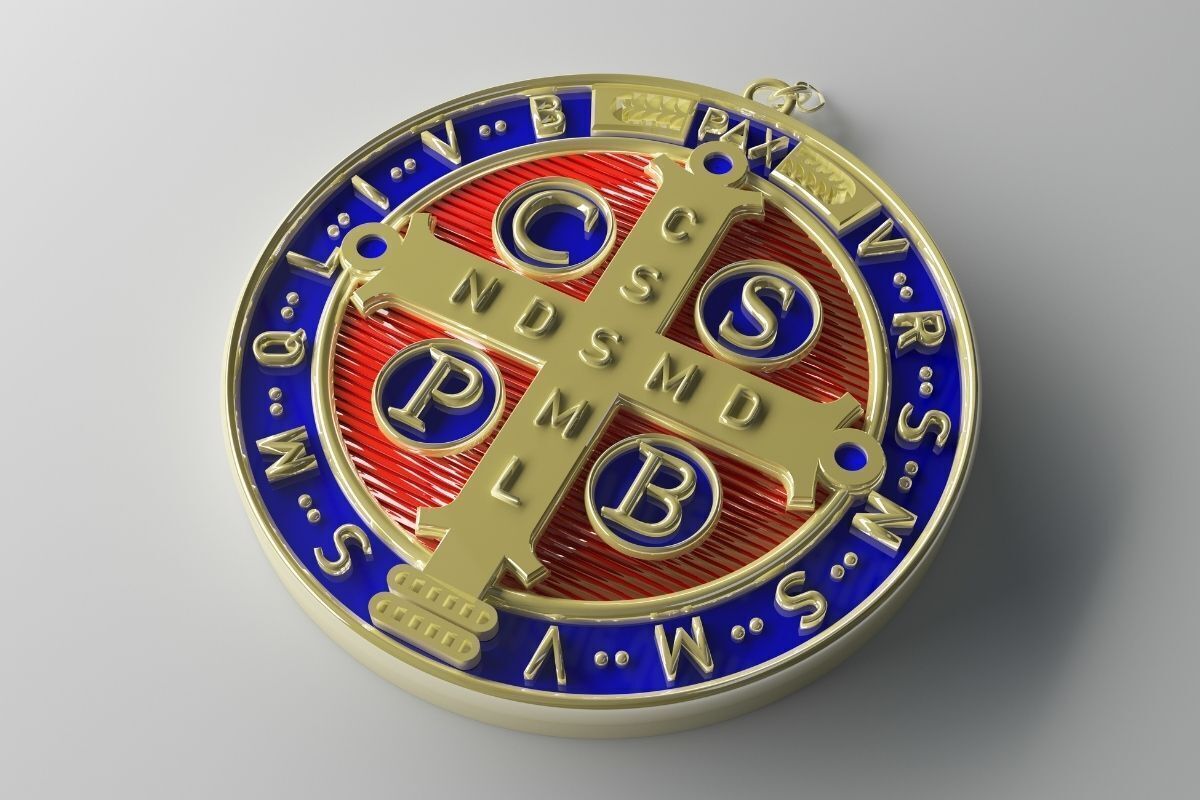
When he died in 547, Saint Benedict left many disciples in the various monasteries that he founded during his life. Shortly after his death, the Benedictine monks created the medal in honor of the master. Therefore, the medal is personalized, unique, and through the details that it carries it is possible to understand a little of the life of the saint.
The monks of the Order of Saint Benedict created the medal based on events that occurred in the life of the Saint, and it is officially declared as a sacramental (sacred object) by the Catholic church. The medal has several symbols, being the cross the object that Saint Benedict most believed in and used as inspiration
The sacramental objects as the Medal of Saint Benedict, added of the individual faith of who uses, transmit the power of accomplishment, of strengthening of the force of will not being, therefore, a simple amulet. In this article you will find all the history of the Medal of Saint Benedict. Enjoy the reading.
Getting to know Saint Benedict of Norcia
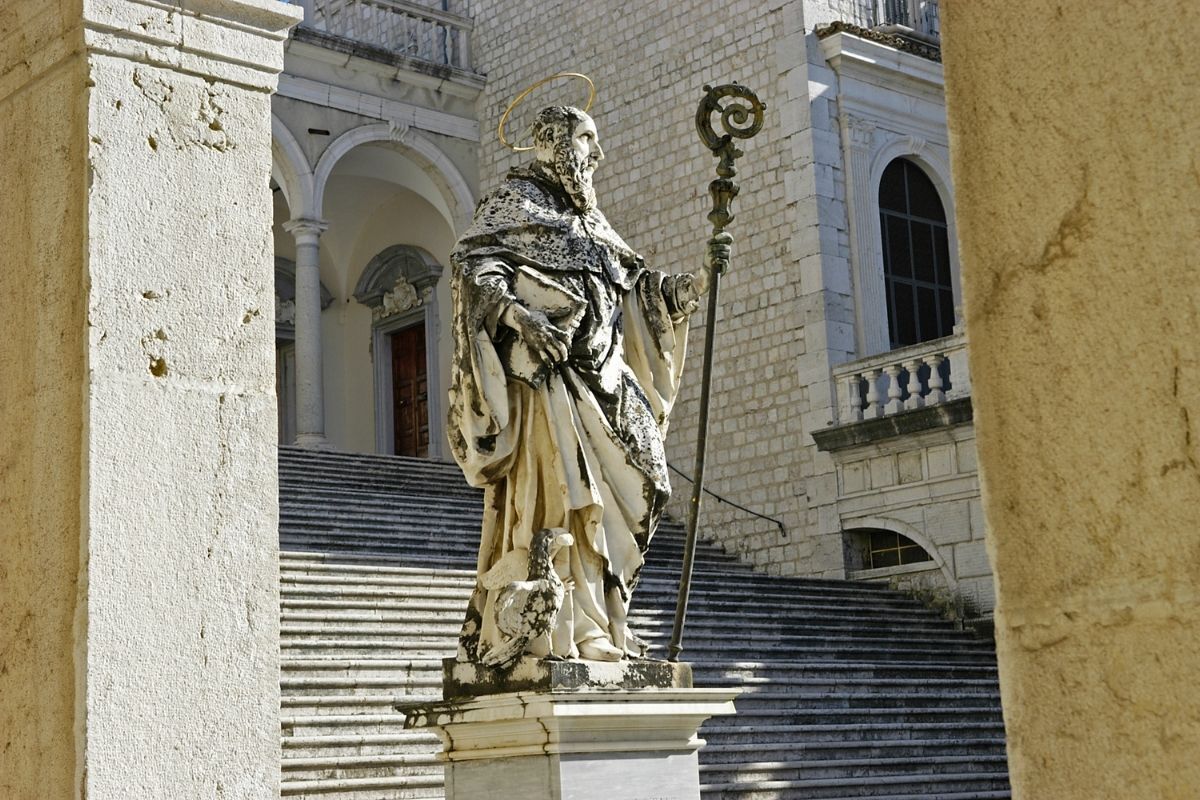
To understand the meaning of the Medal of Saint Benedict, you need to know the details of the life of the Saint, who renounced the privileges of a life among the rich to follow what his heart asked. In the following text, which is divided into blocks for better understanding, you can learn the whole story of Saint Benedict.
Origin of São Bento
His baptismal name is Benedict of Norcia and he was born on March 24, 480. He came from a noble Roman family, which sent him to Rome, capital of the Roman Empire, to continue his studies. Rome was then one of the largest cities in Europe, although the empire was already in decline.
However, the prevailing way of life in Rome was degrading, since the decadence of the empire was reflected in the moral aspect of the inhabitants, which did not please the young nobleman who had other desires. Thus, the young man preferred to leave the capital and lived for three years in a cave as a hermit, to meditate and strengthen his religious vocation.
Visual characteristics
Saint Benedict came from a wealthy family in Italy, but he lived as a hermit for some years, and this fact already shows the absence of vanity. Thus, his clothing was simple without luxury or ostentation. His first monk's cassock was given to him by an abbot named Romero who helped him while he lived in the cave.
Saint Benedict wore a tall staff that ended in a cross and this is the most common visual representation in images of the saint. Some of his images also show the chalice and the raven, which symbolize the two most well-known miracles attributed to the saint.
What does São Bento represent?
The life of Saint Benedict shows by example that he was a selfless and faithful devotee of Christ. The foundation of the monasteries signifies the understanding that it was necessary to form others who would continue his work, bringing to the world the message of the power of the cross, an object he revered.
Thus, Saint Benedict is the example of the power of faith through sacrifice and renunciation, and he also represents the struggle that the faithful face against temptations. Saint Benedict also symbolizes the strength of will that nourishes the actions of holy men in the arduous task of fighting the power of darkness.
Life story
The story of St. Benedict's life is touching because he knew wealth, as well as the promiscuous life of Rome, where he could have lived amidst the delights of flesh and the power of money. However, he gave all this up to live in a cave, and later in monasteries.
The life of voluntary seclusion in monasteries is difficult, for one must produce the resources for subsistence. In addition, considerable time is devoted to study to strengthen one's faith, having none of what is known as entertainment. This was the real life story of St. Benedict, which resembles that of many other saints.
Sanctification
Saint Benedict was made a saint by the Catholic Church in 1220 by Pope Honorius III, obeying the church's tradition of sanctifying martyrs and other personages who had proven miracles, as well as a life dedicated to fulfilling duties for the church.
Since the saint died in 547, it took about seven hundred years for the church to recognize the sainthood and finalize the process. In the meantime he was already a saint in the hearts of many devotees.
Miracles of Saint Benedict
The performance of at least two miracles is a requirement for the church to recognize a saint. St. Benedict's first miracle saved his life when a group of disgruntled monks tried to poison him with wine. The cup broke when the saint blessed it before drinking the wine.
Years later, he again saved his own life in another assassination attempt. This time, a priest overcome by envy sent bread with poison, but Saint Benedict gave the bread to a raven, which, although it was waiting for crumbs, did not even pinch the poisoned bread.
The Rule of St. Benedict
As the name suggests, the Rule of St. Benedict is a manual of instructions for a good coexistence among the monks, and also to regulate and distribute all the work that was performed by the monks in the monasteries. St. Benedict had a lot of experience in this area, as he helped found 12 monasteries.
These rules unified the necessary acts within a convent, which previously functioned following rules that each abbot created. In addition, it was St. Benedict's rules that gave birth to the Benedictine Order, albeit many years after his death.
The Medal of Saint Benedict
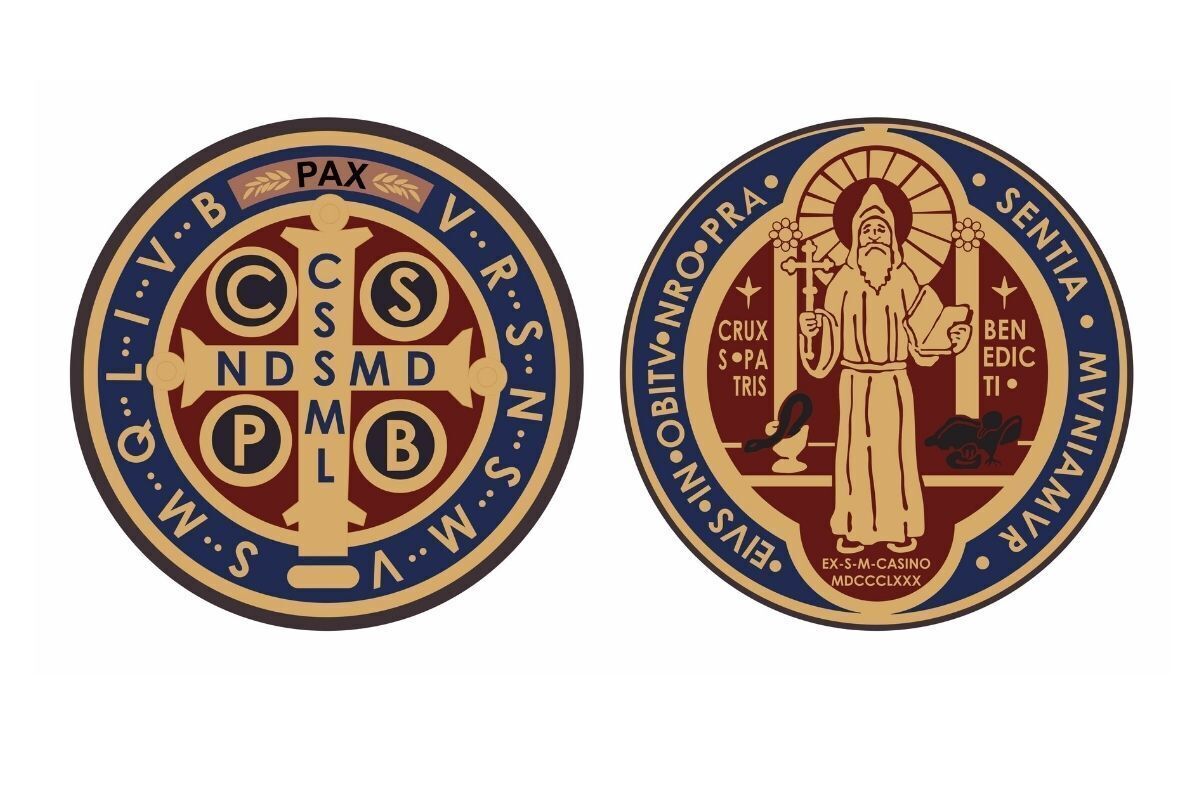
You will now know the history of the Medal of Saint Benedict, a catholic sacramental of great cultural, historical and religious value. If you believe that some objects can have an energy of their own, the Medal of Saint Benedict has all the requirements to be one of these objects.
Origin and history
The medal that is most in use today is the one commemorating the 1400th anniversary of Saint Benedict, which would take place in 1880, when the medal was created to honor the date. However, medals with different designs can still be found, as they have changed over time.
There is no official date for the first medals, which carried only a cross, the monk's object of devotion. Then they added the image of Saint Benedict with the book of monastic rules. Later modifications included the many letters of words in Latin, in addition to the images of the chalice and the raven, and this is the most common model.
Meaning
The main meaning of the medal is to invoke the powers of Saint Benedict through faith because the medal itself is not a magical object. However, it contains the cross and the objects with which they were present in the two miracles that sanctified and eternalized the man Benedict.
Thus, the medal signifies the recognition of the victories of Saint Benedict in the face of enemy forces, which always tried to remove him from the path. The wearing of the medal brings the wearer closer to the forces of good, thus increasing his own strength.
Approval by Pope Benedict XIV
The Catholic church has always cultivated the tradition of creating relics of men who have been sanctified. Besides the expression of faith, the relics served, and still serve, not only to attract the faithful, but also to contribute to the church's income once they are put up for sale. Thus, many objects have been considered sacred by the church and among these is the Medal of Saint Benedict.
An object can only become a sacred relic after it has been authorized by a Pope, at which point it gains the name sacramental. The Medal of St. Benedict obtained authorization from Pope Benedict XIV to include the image of the cross in 1741 and was made official as a sacramental in 1942.
What does the medal look like?
The Medal of Saint Benedict can be found in various versions and materials because it is not only sold by the church. Just like a crucifix, it can be made in slightly different shapes, but the most well-known official version is the Jubilee Medal, when Saint Benedict would have been 1400 years old.
Unlike other sacramentals that were objects that belonged to the saint, the Medal of Saint Benedict brings together a set of objects, such as the cross, for example, and phrases that help tell the story of the saint. In addition, the first medal was minted long after his death.
The front of the Saint Benedict medal
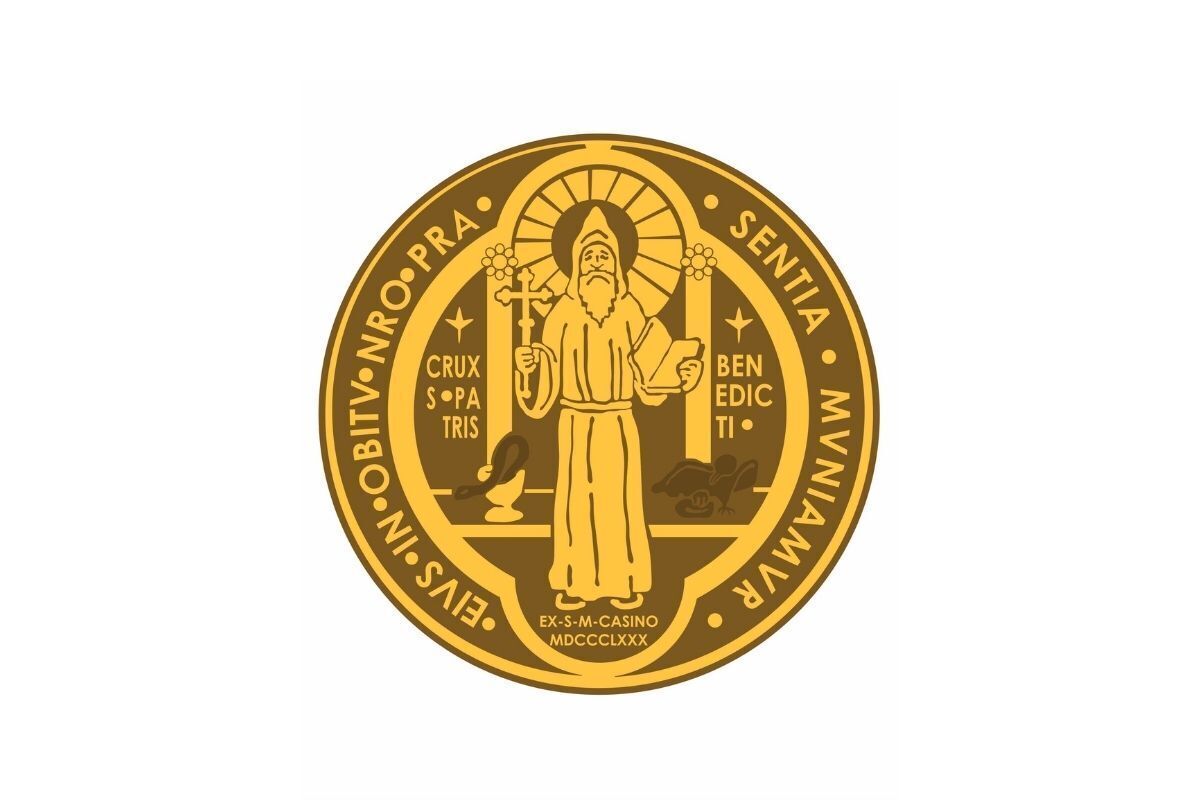
The present medal gathers so many elements that both sides are used to display them. Thus, on the front side alone there are five, which will be detailed shortly below. They are: the image of the best known saint, an inscription in the original in Latin, and the images of the cross, the book and the crosier.
The image of Saint Benedict
In the most traditional image of Saint Benedict, the saint holds the cross in his right hand, being one of the most important symbols of Christianity, while his left hand holds the book in which he wrote a set of rules that became known as the Rules of Saint Benedict.
The image of the saint, which today is just another element of the medal, was the only one that appeared in the primitive versions, when it still did not have authorization of the church to be manufactured. Today, the medal appears in several different styles, because besides attending to the religious sentiment, it is commercialized all over the world.
Latin Inscription
Of the Latin inscriptions that are inserted in the medal, the first does not require comment, but only the translation that informs the name of the person honored by the medal. Thus, the phrase "Crux Sancti Patris Benedicti" is translated to Holy Cross of Father Benedict. The second Latin phrase refers to the date of the 1400th jubilee in 1880 in Monte Cassino and reads: SM Casino, MDCCCLXXX'.
Finally there is the third sentence "Eius in Obitu Nostro Praesentia Muniamur!" means "May We Be Strengthened By His Presence in the Hour of Our Death!" The text makes a reference to the title of patron of good death, which St. Benedict earned for dying peacefully after having foreseen it six days earlier.
The cross
The cross was already known as a mystical object even before Christ turned it into the great symbol of Christianity. With the crucifixion, it came to signify the difficulties that everyone must face during life, and at the same time the trust that Jesus would help those who believed in him.
Saint Benedict was always a devotee of the symbolism of the cross, recommending everyone to always make the sign of the cross several times a day. His devotion caused a Pope to authorize that a cross be added to the Medal of Saint Benedict, a fact that gave the saint more power of recognition.
The book
The book that Saint Benedict wrote to systematize the functioning of a monastery is still used today in both male and female religious establishments. It is a set of rules that determine everything from the relationships among the inmates to the schedules of all activities.
The book also served to unify the monasteries that adopted it as their norm, and from this unification was born the Benedictine Order, the largest Order in Catholicism. The main rule was Pax (peace in Latin), and Ora et Labora (pray and work) which are the two main (and perhaps the only) activities in a monastery.
The crosier
A staff, in its common and primitive sense, is a piece of wood or staff that shepherds used in their work. Its end makes a curve at the end so that the shepherd can catch the sheep by the foot or neck. The end that goes to the ground should have a sharp point, and serves as an instrument of defense.
When religions began to call men sheep, their representatives adopted the use of the crosier to resemble shepherds. In the Catholic hierarchy and liturgy, only the high clergy may use the crosier, which came to represent a symbol of religious authority.
The back of the Saint Benedict medal
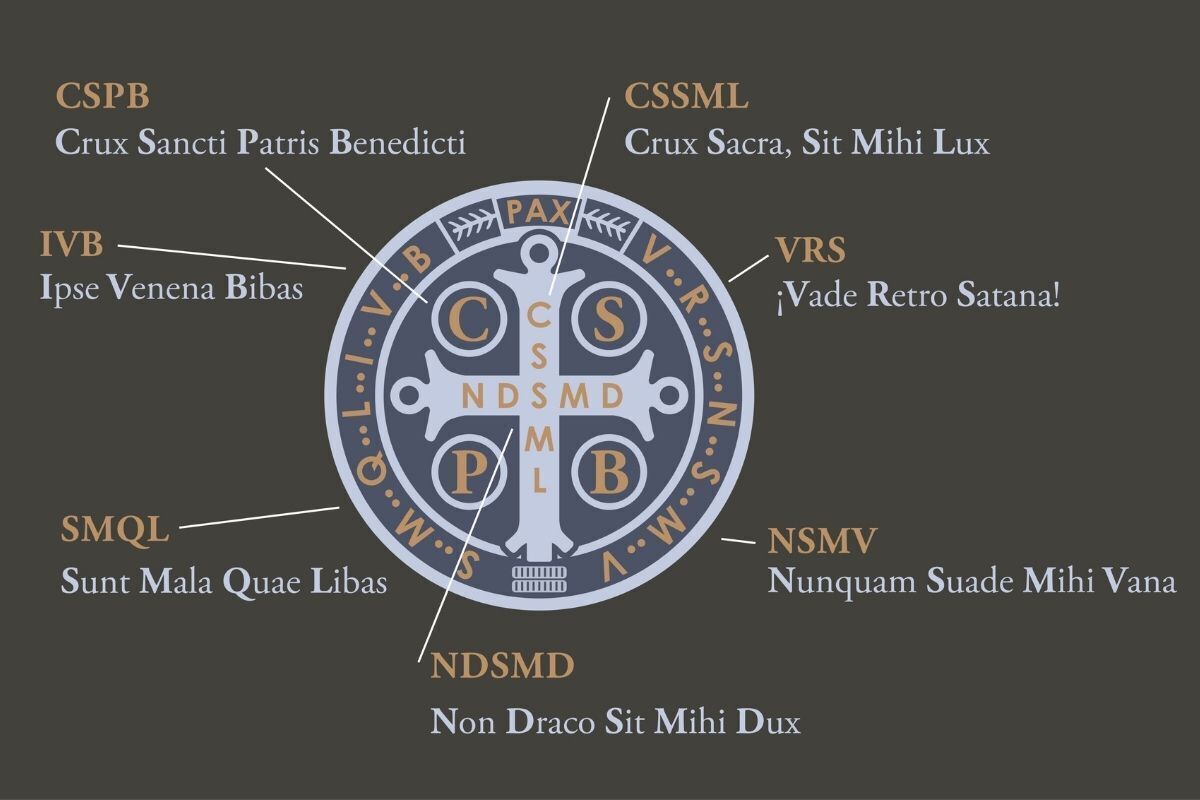
The back of the Medal of Saint Benedict was reserved for the symbolism of his prayer in Latin, a cross that has some of these inscriptions, and some more that are surrounding the entire length of the medal. Below you will see each item with its respective description.
PAX
The word Peace (Pax in Latin) appears both on the front and on the back of the medal, probably signifying the great difficulty the faithful have in reaching this goal.
Thus, peace is an achievement of those who follow in the footsteps of Christ, who promised it in his short time on earth. Even St. Benedict and other faithful followers of Christ had a life full of difficulties, which confirms peace as a prize to be enjoyed only in the kingdom of God.
The Cross of Saint Benedict
The cross is present on both sides of the medal, and represents the trials that must be endured by men to gain heaven. The cross is synonymous with sacrifice and devotion, as well as courage and persistence. Only those who carry their cross without lamentations and blasphemies against God will overcome the test.
Saint Benedict carried his cross with dignity and courage as he spent years of privation in a cave and suffered two assassination attempts, among other mishaps. Still, he always encouraged the use of the sign of the cross as a means to obtain help and deliver oneself from the forces of evil.
CSPB
The letters CSPB are an abbreviation for "Crux Sancti Patris Benedicti" which translates into the expression the Holy Cross of Father Benedict. The four letters correspond to each of the quadrants of the medal. The quadrants are formed by the cross that divides the medal into four equal parts.
CSSML
The inscription CSSML forms an acronym for the Latin expression "Crux Sacra Sit Mihi Lux," which when translated means: The Holy Cross Be My Light. The phrase is the first verse of the prayer of Saint Benedict, and is located on the vertical arm of the cross. Father Benedict's prayer, like the medal, was written after his death.
The Holy Cross Be My Light is a phrase that makes very evident the faith that St. Benedict had in the power of the cross. The sign of the cross was a constant habit of the priest, and by making this sign before the chalice with poison, occurred the first proven miracle of the priest, since the cup broke.
NDSMD
The set of letters NDSMD is located on the horizontal arm of the cross, and the letter 'S' is the point of intersection between the two arms, and is also included in the CSSML inscription.
NDSMD means "Let Not the Dragon Be My Guide", and is the translation of "Non Draco Sit Mihi Dux". The expression continues the prayer of St. Benedict, being its second verse. It translates the struggle that one must wage in order not to be dominated by the devil.
VRSNSMV
To find in the medal the grouping of letters V R S N S M V, you must look at the top of the medal and follow clockwise. The corresponding Latin expression is: Vade Retro Satana, Nunquam Suade Mihi Vana. The translation leaves the phrase with this sense: Withdraw Thyself Satan, Do Not Persuade Me of Thy Vanities.
The Latin expression is very popularly known as a phrase of power in exorcisms. It means a weapon against the temptations that the evil forces bring down upon all men.
SMQLIVB
S M Q L I V B, is the Latin acronym for Sunt Male Quae Libas, Ipse Venena Bibas. Translated, the phrase means "What You Offer is Evil, Drink Thyself Your Poison." This sequence of letters continues around the medal clockwise and closes the spaces, making reference to the chalice with poison that was broken in the miracle of St. Benedict.
The Medal of Saint Benedict is considered a true Sacramental!
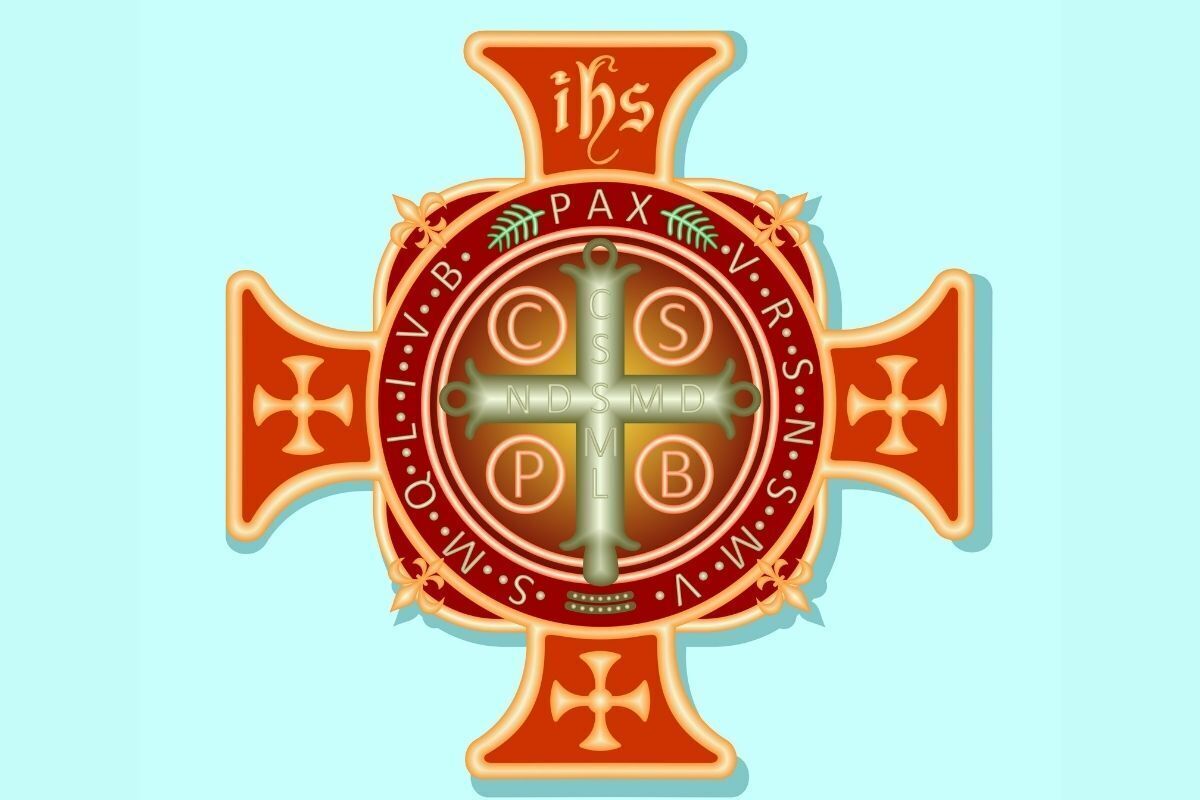
In the beginning, the medal of Saint Benedict had a simple shape and contained an image of the priest with his cross. In order for it to become a sacramental, the church added all the objects and power phrases that had some connection with Saint Benedict. It was constructed for that specific purpose.
Thus, the belief in the medal has only increased over the years. For the medal to perform this function it is necessary to take it to a priest and perform the proper ritual of the church. Only after the blessing the medal ceases to be an ordinary object and becomes a sacred symbol.
Finally, it is important to emphasize that much of what was written here is an article of faith, which is the basis of the entire structure of the Catholic religion and many others. Moreover, many historical facts usually have different versions. Thus, it is up to each one to believe or not in the powers of the Medal of St. Benedict.

